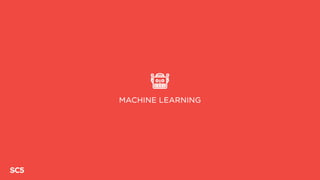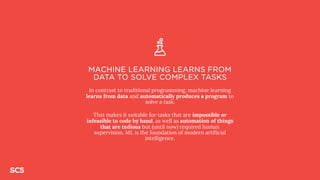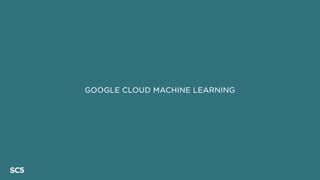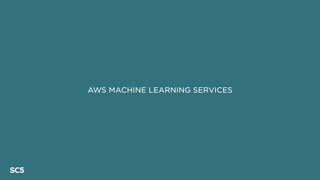AWS Machine Learning & Google Cloud Machine Learning
- 1. AWS & GOOGLE MACHINE LEARNING SERVICES 11.10.2017 Max Pagels, Machine Learning Specialist @maxpagels, linkedin.com/in/maxpagels/
- 2. ABOUT ME • BSc, MSc in Computer Science (University of Helsinki) • Currently doing applied machine learning at SC5, a consultancy based in Helsinki • Former CS researcher • Current favourite ML algorithm: LSTM neural networks • Favourite programming languages: JavaScript for full-stack, Python for ML • Other hats I wear: full-stack developer, technical interviewer
- 3. AGENDA Part 1: Overview of AWS & Google machine learning services 〜 〜 〜 Part 2: Classification demo using Google ML Engine and AWS ML 〜 〜 〜 Part 3 (time permitting): Free-form Q&A
- 4. IF YOU HAVE ANY QUESTIONS, AT ANY TIME, DO ASK!
- 6. MACHINE LEARNING LEARNS FROM DATA TO SOLVE COMPLEX TASKS In contrast to traditional programming, machine learning learns from data and automatically produces a program to solve a task. That makes it suitable for tasks that are impossible or infeasible to code by hand, as well as automation of things that are tedious but (until now) required human supervision. ML is the foundation of modern artificial intelligence.
- 8. TRADITIONAL PROGRAMMING Input → Algorithm → Output
- 9. MACHINE LEARNING Input & output → Learning algorithm → Program
- 10. THERE ARE 3 MAIN TYPES OF MACHINE LEARNING SUPERVISED LEARNING Learn from labelled data to build a model for predicting a number (regression) or a a discrete class (classification) on new data UNSUPERVISED LEARNING Find structure in unlabelled data to provide insights REINFORCEMENT LEARNING Take actions in the world, receive rewards, and learn to maximise reward over time
- 11. MACHINE LEARNING IS RESOURCE- INTENSIVE ML models learn from data using numerical optimisation and linear algebra. It’s not uncommon for each pass over training data to require thousands or even millions of mathematical operations. Inference (predicting/classifying new examples) is also expensive.
- 12. THE CLOUD OFFERS CPU/GPU COMPUTE ON-DEMAND In addition to infrastructure-as-a-service, the big cloud vendors (Azure, Google, AWS) also offer a number of managed and hybrid ML & AI solutions.
- 13. LET’S TAKE A CLOSER LOOK AT THE SERVICES PROVIDED BY GOOGLE AND AMAZON (AWS)
- 14. GOOGLE CLOUD MACHINE LEARNING
- 15. From their website: “Google Cloud's AI provides modern machine learning services, with pre-trained models and a service to generate your own tailored models. Our neural net-based ML service has better training performance and increased accuracy compared to other large scale deep learning systems. Our services are fast, scalable and easy to use. Major Google applications use Cloud machine learning, including Photos (image search), the Google app (voice search), Translate, and Inbox (Smart Reply). Our platform is now available as a cloud service to bring unmatched scale and speed to your business applications.”
- 16. BREAKDOWN OF GOOGLE AI SERVICES FULLY MANAGED APIS • Cloud Jobs: machine learning-powered job search engine • Cloud Video Intelligence: extract metadata, identify key nouns, and automatically annotate the content of videos using a REST API • Cloud Vision: image classification, object recognition and OCR as-a-service • Cloud Speech: audio-to-text • Natural Language: extract information about people, places, events etc. Sentiment analysis supported • Cloud Translation: language translation á la Google Translate HYBRID/BYO • Machine Learning Engine: general- purpose machine learning training and inference engine • Implement your own learning algorithms in TensorFlow, provide training data, train in the cloud without worrying about servers • Deploy trained models in the cloud for a scalable server less prediction API • Can also do training and/or inference on your local machine
- 17. AWS MACHINE LEARNING SERVICES
- 18. From their website: “Within AWS, we’re focused on bringing that knowledge and capability to you through three layers of the AI stack: Frameworks and Infrastructure with tools like Apache MXNet and TensorFlow, API-driven Services to quickly add intelligence to applications, and Machine Learning Platforms for data scientists.”
- 19. BREAKDOWN OF AWS AI SERVICES FULLY MANAGED APIS • Amazon Lex: natural language understanding and speech recognition, powered by the same AIs used in Alexa • Amazon Polly: text-to-speech as-a- service • Amazon Rekognition: ready-made image recognition, object recognition, and OCR FULLY MANAGED SERVICES • Amazon Machine Learning: linear and logistic regression as-a-service • Provide data, choose learning algorithm, train in the cloud • Deploy a trained model as a prediction API in the cloud BYO/PLATFORM SERVICES • Amazon EMR: Managed Hadoop/Spark environment, implement your algorithms/training/inference yourself • Amazon Deep Learning AMIs: spin up instances on EC2 preinstalled with TensorFlow, MXnet, Theano, Caffe, CNTK, Torch etc. and handle the rest yourself • Amazon EC2: spin up instances with the CPU/GPU power you require and install whatever you like
- 20. A NOTE ON PRICING
- 21. Cloud services are typically pay-as-you-go/pay for what you use. For machine learning, that usually means you pay for time/resources needed to train, and time needed to do predictions. Unless you use a service that explicitly spins up hardware and keeps it running, you typically don’t pay anything if you aren’t doing training/inference. PRICING EXAMPLE (CLOUD INFRASTRUCTURE)
- 22. PRICING EXAMPLE (CLOUD INFRASTRUCTURE) Example: on AWS EC2, a p2.8xlarge instance has: • 32 vCPUs • 488 GiB RAM • 8 NVIDIA K80 GPUs, 2,496 PPCs and 12GiB of GPU memory per GPU
- 23. PRICING EXAMPLE (CLOUD INFRASTRUCTURE) Cost of buying one K80 yourself: 5,000 € Cost of buying the equivalent hardware yourself: 50,000 € Cost of running the instance in AWS: about 8 € per hour 50,000 € equals 260 consecutive days of p2.8xlarge use
- 25. MULTI-CLASS CLASSIFICATION USING GOOGLE ML ENGINE & AWS MACHINE LEARNING
- 26. THE IRIS DATASET There are lots of freely available ML datasets online (for example on Kaggle). One of them is the legendary Iris flower dataset. It includes three iris species with 50 samples each as well as some properties (features) about each flower: sepal length, sepal width, petal length & petal width (in cm). With Google ML engine and AWS Machine learning, we are going to train an ML model on the iris data to build a classifier that can correctly classify new examples as one of three iris species (classes).
- 27. LEARNING ALGORITHM: LOGISTIC REGRESSION Logistic regression is a simple learning algorithm. It’s similar to linear regression, but meant for classification problems.
- 28. LOGISTIC REGRESSION OVERVIEW 1. Assume a linear relationship between features: L = w₁ * sepal_width + w₂ * sepal_length + w₃ * petal_width + w₄ * petal_length 2.Use a sigmoid function to convert the result to a probability of belonging to a class: H(L) = sigmoid(L) = 1 / (1 + e^(-L)) 3.Build 1) & 2) for each possible class 4.Iterate over our dataset, construct H(L) for each example, check how far we were from the correct class (we have the correct answers in our labelled dataset) 5.Adjust weights w₁, w₂, w₃ and w₄ so that, on average, we get things less wrong next time (note: use partial derivatives) 6.Iterate 4)-5) until we achieve good accuracy (i.e. classify as many examples correctly as possible) 7. Stop iterating when accuracy is “good enough” or after some predetermined number of iterations
- 29. REMEMBER: G-I-G-O GIGO stands for “Garbage in, garbage out”. Without quality, cleaned source data machine learning won’t work well. Some estimates say that feature engineering & data cleaning account for 80% of data scentists’ work
- 30. WALKTHROUGH: AWS MACHINE LEARNING
- 31. WALKTHROUGH: GOOGLE CLOUD ML ENGINE
- 32. Google Cloud Machine Learning Engine AWS Machine Learning Service type Hybrid Fully managed Supported algorithms Linear and non-linear learners (DNNs, linear & logistic regression, Bayesian learners etc.) Only linear learners (linear & logistic regression) Algorithm implementation BYO: Build using Tensorflow (low-level API or Estimators) or Keras (tf.contrib.keras) Pre-defined (linear & logistic multi-class regression) Accepted data sources Google Cloud Storage, BigTable & other Google Cloud platform storage services S3 (CSV-formatted data), RedShift Built-in data transformation tools Full control (TensorFlow functionality + packaging of Python modules as dependencies) Limited, using “Recipes” (editable in the console UI) Model training In the cloud or locally In the cloud GPU support for training Yes No? Hyperparameter tuning Full control + automatic tuning Limited manual tuning (regularisation, epochs) Cross-validation Yes, configurable Yes (configurable train/test sets but no K-fold) Model versioning Explicit Implicit Underlying computation engine TensorFlow AWS EMR (Spark MLlib?) Real-time predictions Yes, using Cloud Engine Prediction API Yes (built-in) Batch predictions Yes, using Cloud Engine Prediction API Yes (built-in) Monitoring Yes (Training jobs console, TensorBoard) Yes (CloudWatch and AWS ML UI)
- 33. WHAT WE SAW WAS TWO SIMPLE DEMOS…
- 34. BUT THE POSSIBILITIES ARE ENDLESS



































